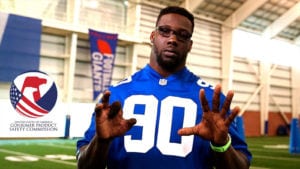Jason Pierre-Paul’s Career Altering Fireworks Injury
On July 4, 2015, NFL defensive end Jason Pierre-Paul was injured when a firework he lit exploded near his right hand. The mangling injury required multiple surgeries to heal, but permanently disfigured his hand and affected his playing career. Thankfully, his high profile injury brought much needed attention to the problem of firework injuries, and he now has participated in a public service announcement to educate the public about the dangers of fireworks.

Approximately 10,000 Americans are injured by fireworks every year, with over two-thirds of those injuries occurring around the 4th of July. Hand surgeons end up seeing many of these injuries because the upper extremities are the most commonly injured body part, with over one third of injuries involving the fingers, hand, and wrist.
Injuries from fireworks have occurred with every type of firework, including:
-
-
- Sparklers
- Firecrackers
- Rockets
- Flare/fountains
- Mortar shells
-
Fireworks can cause both burn and blast injuries. Over half of fireworks injuries are burn injuries. Fireworks are dangerous because they are incredibly hot: a sparkler burns at temperatures of up to 2,000 °F. Most fireworks also produce an explosion. Both the pressure wave from the explosion and the high velocity projectiles ejected from the firework can tear skin, break bones, and cause other soft tissue injuries.
While most firework injuries are mild and can be treated in the outpatient setting, many others, like Pierre-Paul’s, can be devastating, limb-compromising, and life-altering injuries. These injuries can take several surgeries and multiple years to recover. An average of 8 people die yearly from recreational fireworks use.
Firework injuries most often occur because of misuse. For example, when fireworks are pointed or thrown at another person, or when shells are held in the hand, the risk of injury increases.
Sometimes, firework malfunction apart from human error. For example, a rocket may shoot in an errant direction, a mortar may tip over, or a shell may explode earlier than expected. Failure to retreat quickly enough is another common reason for injury.
Who is impacted the most from firework injury? How can injury be prevented?
It should be noted that children are particularly at risk for firework injuries. Children younger than age 15 account for about 35% of injuries. Over 90% of those injuries injuries in children occur unsupervised by adults.
Following these tips can help prevent injury while allowing you to still enjoy fireworks:
-
-
- Never allow young children to play with or ignite fireworks
- Always have adult supervision
- Have a bucket of water or a hose handy in case of a fire
- Never try to re-light fireworks that have not ignited fully; douse them with water after 20 minutes
- Never use illegal or homemade fireworks
- Refrain from using alcohol when using fireworks
- Never place your body or face directly over fireworks when lighting the fuse.
- Immediately back up to a safe distance
- Never shoot fireworks from your hand
- Never point or throw fireworks at another person
-
This 4th of July, remember that when playing with fireworks, your life can change in a split second. Enjoy the holiday, but keep in mind the words of Jason Pierre-Paul: “Now when I look at fireworks, I think about safety.”
Have you been injured due to fireworks? Let’s get you treated. Request your appointment here.


